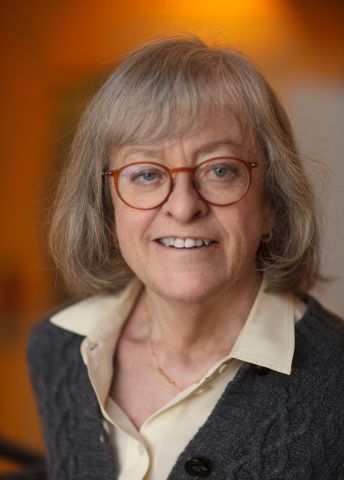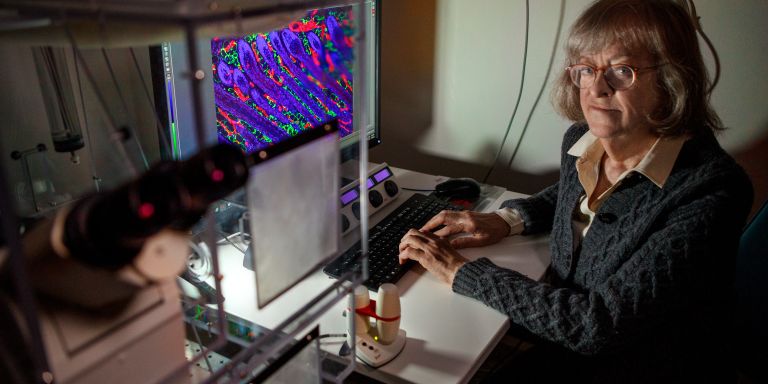
Lena Claesson-Welsh
Professor of Medical Biochemistry
Wallenberg Scholar
Institution:
Uppsala University
Research field:
Mechanisms of blood vessel regeneration and blood vessel leakage.


Wallenberg Scholar
Institution:
Uppsala University
Research field:
Mechanisms of blood vessel regeneration and blood vessel leakage.
Claesson-Welsh is a professor at Uppsala University and a well-known vascular biology expert. When she started her career, the study of blood vessels and their cells – endothelial cells – was still in its infancy.
“Initially it was difficult to study endothelial cells. They were very difficult to isolate and grow,” she says.
A breakthrough came with the discovery of a specific growth factor, VEGF, and its receptors. This became the key to understanding how blood vessels grow and how their permeability is regulated.
“Suddenly it was possible to study blood vessels in a completely different way, both in the dish and in tissues,” Claesson-Welsh explains.
Now there’s a greater awareness of how healthy blood vessels affect health. The walls of blood vessels function as important barriers in the body. They regulate the flow of fluid, molecules and cells between blood and tissue.
“The entire body is bathed in fluid that flows back and forth.”
The barrier in healthy blood vessels is strictly controlled, but if it weakens, this results in exaggerated leakage. This, in turn, can give rise to swelling, inflammation and the spread of cancer
One of the things Claesson-Welsh is looking into is the link between blood vessel leakage and lung cancer, the incidence of which is increasing worldwide due to factors such as smoking and air pollution. In the Western world, lung cancer has decreased in men but continues to increase in women.
“We see that the body’s immune response to lung cancer is weakened, probably because leakage from blood vessels affects the tumor microenvironment.”
This is also one reason immunotherapy does not work as effectively as desired for these patients. More research is needed on how to strengthen the blood vessel barrier.
Claesson-Welsh’s work as a Wallenberg Scholar includes investigating how the blood vessel barrier function is controlled. She is currently focusing on three closely related enzymes: Src, Yes, and Fyn. One exciting discovery is that these highly related enzymes seem to have different roles in regulating blood vessel permeability.
“Unexpectedly, these three turn out to have very distinct and even opposite functions. Some of them stabilize cell-to-cell contacts in blood vessels, while others break them down.”
The researchers are using advanced techniques, including real-time microscopy to study vascular leakage.
“We’ve developed a method that allows us see the leakage in real time,” says Claesson-Welsh. “We can follow how endothelial cells interact and how leakage occurs at the molecular level.”
They also use mouse models in which one of the enzymes regulating leakage can be blocked to study the effect leakage suppression has on tumor growth, blood vessel leakage and the immune system’s ability to fight cancer.
One of the project’s goals is to pave the way for new and more effective drugs, for example for lung cancer. One approach involves to stabilize endothelial cell contacts in blood vessels to prevent leakage. There are already results that demonstrate that leakage can be prevented in the skin. The next step is to investigate the same mechanism in eye disease.
Our research concept is unique, so I have hopes that there will be interest in future drug treatments.
“Cancer and eye diseases are of course very different conditions, but the way the blood vessels change have common denominators,” explains Claesson-Welsh.
VEGF has a role in several eye diseases, such as in diabetic retinopathy when small blood vessels in the retina become leaky, and in macular degeneration, where there is a growth of blood vessels under the macula. Both of these diseases are age-related and increase as we live longer.
Treatments that completely block VEGF in the eye have been available for about 10 years. This approach reduces blood vessel leakage, but in the longer term it causes blood vessels to die. Although offering short-term relief, alternative therapies that stop leakage and at the same time, allow blood vessels to survive, are much needed.
The idea is to break the negative cycle at an early stage by focusing on preventing the breakdown of endothelial cell contacts rather than trying to repair them after damage has already occurred.
Converting groundbreaking research into clinical treatments is a complicated and often time-consuming process.
“It’s so difficult to develop drugs that you start to wonder how any drugs exist at all,” notes Claesson-Welsh.
She is nevertheless hopeful for the future, and if the research is successful, there are plans to form a start-up company to license the patents and the product. The timeframe makes long-term research support extra important.
More effective treatments will be vital to improve patients’ quality of life. But people also need to have healthy lifestyles as a form of preventive medicine.
“It’s important to do what we can to slow down the aging of blood vessels.”
New, exciting results suggest that a small increase in the amount of VEGF in the blood may improve blood flow and blood vessel health.
“There’s some fascinating data showing that slightly increased levels of VEGF may result in significantly longer and healthier aging in mice, and we want to know more about that,” says Claesson-Welsh.
Text Nils Johan Tjärnlund
Translation Nick Chipperfield
Photo Magnus Bergström